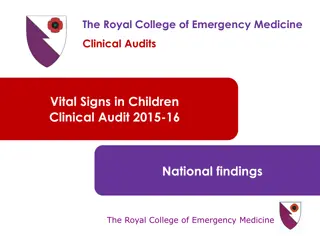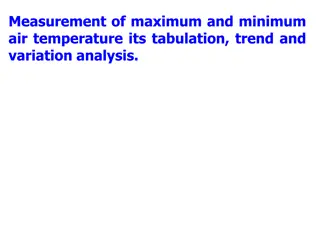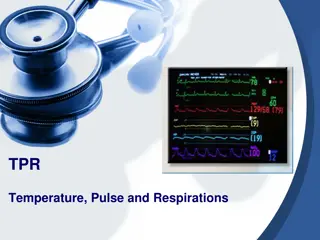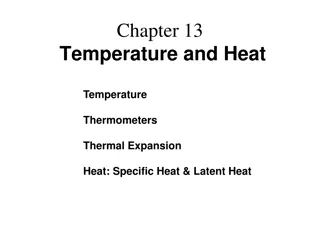Understanding Vital Signs and Temperature Measurement
Vital signs, including temperature, pulse, respiration, blood pressure, skin color, level of consciousness, and pupil size, are crucial for assessing a person's health. Temperature measurement is a key indicator of the body's homeostasis and can be taken via different routes using various types of thermometers. Knowing the normal temperature ranges and how to properly use and read thermometers is essential for accurate health assessment.
Download Presentation

Please find below an Image/Link to download the presentation.
The content on the website is provided AS IS for your information and personal use only. It may not be sold, licensed, or shared on other websites without obtaining consent from the author. Download presentation by click this link. If you encounter any issues during the download, it is possible that the publisher has removed the file from their server.
E N D
Presentation Transcript
Vital Signs include Temperature Pulse Respiration Blood Pressure Skin Color Level of Consciousness Pupil Size, Reactivity & Trackability
Vital signs are interdependent of each other because a change in one will affect another. Like a rise in temperature will increase respiration rate.
Temperature Temperature is one way we can determine the body s level of homeostasis & refers to temperature inside the body or core body heat.
Temperature Four of the most commonly used routes measured are: 1. Oral 2. Rectal 3. Axillary 4. Tympanic
Temperature Several types of thermometers 1. Electronic/Digital 2. Glass /Mercury 3. Clinical
Normal Temperature Ranges 1. Oral 97.6 degrees F. 99.6oF. Most common site to measure tempt. 2. Axillary 96.6 degrees F. 98.6oF. Least accurate site measured 3. Rectal 98.6 degrees F. 100.6oF. Most accurate site to measure tempt.
Reading Glass Thermometer 1. By degree and tenth of a degree 2. Place thermometer at eye level and look for silver line of mercury 3. Never place fingers on bulb of thermometer as this might change the value. 4. The short lines = .2oF 5. The long lines = 1oF
Color Coding Thermometers 1. Probes for electronic and mercury- free ends are color coded for route. 2. Red = rectal; Blue = oral/axillary 3. If no color present, the route will be written on the thermometer
Using a Thermometer 1. Use protective cover on each type of thermometer 2. Tympanic probe placed in ear canal. 3. Rectal thermometer or probe placed in rectum one inch with lubrication applied before insertion. 4. Oral thermometer placed in mouth under the tongue
Oral Thermometer Use 5. Do not take oral temperatures on a. preschool children b. patients with oxygen c. delirious, confused, disoriented patients d. comatose patients e. patients with nasogastric tubes in place f. patients who have had oral surgery g. patients who are vomiting or are nauseated
Rectal Thermometer Use 6. Do not take rectal temperatures on a. infants or children unless a core temperature is needed b. patients who have had rectal surgery c. combative patients
Duration of Taking Temperature 1. Tympanic a couple of seconds long 2. Oral and rectal (glass thermometer) three minutes. 3. Axillary glass thermometer) 10 minutes 4. Electronic temperatures when beep sounds, temperature is obtained
Abnormal temperatures 1. Fever (febrile), hyperthermia all indicate someone has an elevated temperature (greater than 100oFahrenheit). 2. High fever would include anything over 103o Fahrenheit. 3. Moderate fever would include anything 100 103oFahrenheit. 4. Hypothermia is subnormal temperature. This can be equally problematic for a person. Anything under 96oFahrenheit would indicate hypothermia.
Pulse A. Pressure against the arterial walls when heart is contracting or relaxing. B. Can feel at points where the artery is between finger tips and a bony area. C. These areas are called pulse points and include: 1. Temporal 3. Apical 5. Radial 7. Popliteal 9. Mandibular 2. Carotid 4. Brachial 6. Femoral 8. Dorsal Pedalis 10. Posterior Tibial
Pulse D. Measured by index & middle, or middle & ring fingers over pulse point. E. Do not take with the thumb, since it has a pulse of its own. F. Count for 30 seconds and multiply by 2, or count for 60 seconds
Pulse G. Normal range is 60 100 beats per minute. The pulse should not constantly remain @ 90-100 bpm. H. > than 100 = tachycardia I. < than 60 = bradycardia
Quality of pulse is determined as well as rate 1. Rhythm regular or irregular 2. Strength Bounding or thready
Circumstances affecting pulse rate 1. Body temperature 3. Activity level 5. Age 7. Medications 9. Shock 11. Sleep 2. Emotions 4. Health of heart 6. Sex 8. Illness 10. Bleeding
How to take a pulse How to take a pulse
Perfusion L. Perfusion is the flow of blood throughout the body. Someone with sufficient perfusion has a strong enough heart beat to adequately oxygenate the body.
Respiration A. Each breath includes inspiration and expiration. B. Measure by observing chest rise and fall. C. Measured in breaths per minute. D. Normal Adult range = 12-20 breaths per minute.
Respiration E. > than 24 = tachypnea if breathing in great depth then called hyperpnea F. < than 12 = bradypnea G. Difficulty in breathing is called dyspnea H. Quality of breathing is determined as well as the rate of breathing: 1. Depth 2. Clarity of breath sounds 3. Pain with breathing 4. Difficulty breathing use of accessory muscles sternocleidomastoid, intercostals or trapezius.
Croup http://www.youtube.com/watch?v=nmJzDicuPc4 Http://www.youtube.com/watch?NR=1&v=jJTYLxS662w
Pertusis http://www.youtube.com/watch?v=3akJVesMdvs&feature=related Clinical presentation of Whooping Cough YouTube
Stridor http://www.youtube.com/watch?v=1Enq2BvX9a w http://www.youtube.com/watch?v=obR9Y3Srplg &feature=related
Cheyene-Stokes http://www.youtube.com/watch?v=CrKfmfuP9l4 ED Sing-a-Long: Cheyne-Stoking -YouTube
Rales, Rhonci & Wheezing http://www.youtube.com/watch?v=0Q6J0ybSuN o Adventitious Breath Sounds YouTube
How to take respiration rate http://www.ehow.co.uk/video_4961828_measure -record-respiratory-rate.html
Procedure for taking TPRs Procedure for taking TPRs A. If using glass thermometer, insert the thermometer. If axillary or rectal-hold the thermometer throughout the time. If oral, insert the thermometer and proceed to take the pulse and respiration. B. If using electronic take the temperature first, then proceed to the pulse and respiration
Procedure for taking TPRs Procedure for taking TPRs C. When taking the pulse and respiration, do not drop the wrist until both the pulse and respiration are taken. This way the person does not know when his/her respirations are being measured insuring a more accurate measurement. D. When measuring axillary temperature, remove any clothing that could impede the accuracy of the temperature. Also clean the axilla if there is excessive deodorant or perspiration present.
Procedure for taking TPRs Procedure for taking TPRs E. When measuring the rectal temperatures, always lubricate the thermometer with water-soluble gel before inserting into the rectum. F. Never touch the bulb end of the thermometer with the fingers.
Charting TPR Do not write T =, P =, etc., simply 98.6 84 22.
Instruct on the correct reading of a Instruct on the correct reading of a glass thermometer glass thermometer A. Read between the markings and numbers. B. Large lines indicate full degrees. C. Small lines are two-tenths of a degree.
Blood Pressure BP = The measurement of the force of blood against artery walls. 1. Force comes from the pumping of the heart. 2. If arteries are hardened or narrowed, this force might be increased to pump the blood throughout the body.
Blood Pressure Measurement Measurement is done by listening for two sounds with a stethoscope - the first sound and the change in sound/or in some instances the last sound 1. The first sound is called the systolic blood pressure - it measures the pressure in an artery when the heart is contracting 2. The change in sound/or last sound heard is the diastolic blood pressure - it measure the pressure in an artery when the heart relaxes between contractions
Blood Pressure Measurements BP is measured in units of millimeters of mercury (mmHg). 1. the top number/systolic is charted first, then the diastolic as in systolic/diastolic 2. 120/80 is an example of a normal blood pressure and this would be in millimeters of mercury or mm Hg
Blood pressure values A. Normal range of B/P = 90/60 - 140/90 B. B/P < 90/60 is said to be hypotensive. 1. Hypotension symptoms include: dizziness, light-headedness, & might faint. 2. No presence of signs and symptoms
Blood pressure values 3. Contributing factors include a. Medications c. Illness e. Pain g. Shock i. Family Hx. b. Exercise/fitness level d. injury f. Body position h. Hemmorhage j. diet
a B/P greater than 140/90 mmHg is said to be hypertensive 1. Hypertension is called the silent killer because there are often no symptoms. Some people might experience headache, pressure in the head, ringing in ears, general feeling of malaise. 2. Continued elevation over time may result in a Cerebral Vascular Accident (stroke).
Blood Pressure Blood Pressure Pre-hypertension Hypertension Normal 120 mmHg or less 121-139 mmHg 140 mmHg or higher Systolic (top #) 80mmHg or less 80-89mmHg 90mmHg or higher Diastolic (bottom #)
High blood pressure directly increases the risk of coronary heart disease (which leads to heart attack) and stroke, especially along with other risk factors.
High blood pressure can occur in children or adults. It's particularly prevalent in African Americans, middle-aged and elderly people, obese people and heavy drinkers. People with diabetes mellitus, gout or kidney disease have hypertension more often.
High blood pressure usually has no symptoms. It's truly a "silent killer." But a simple, quick, painless test can detect it. BP monitoring video
How to take blood pressure What bp sounds like: Taking Blood Pressure with Sound's of HeartBeat :) YouTube Self bp w/manual operations: Video: How to measure blood pressure using a manual monitor - MayoClinic.com BP Sounds: Korotkoff Blood Pressure Sights and Sounds on Vimeo
Instruments need to take blood pressure A. Blood pressure cuff/sphygmomanometer 1. This must fit the arm properly. The width of the cuff should approximately equal the width of the upper arm. 2. The gauge should be calibrated and the needle should be on 0 B. Stethoscope
BP Procedure A. Person should be comfortably seated or lying down B. Should have rested for 10-15 minutes prior to the reading C. Arms that are paralyzed, injured, have an IV or shunt should not be used
BP Procedure D. Infant blood pressures can be taken on the leg, but adults must use the arm E. Electronic blood pressure equipment can be used - the type used most often in the hospital setting is the Dyna-map F. Excess air should be squeezed out of the cuff
Taking BP F. Excess air should be squeezed out of the cuff G. Cuff should be placed snugly on upper arm. H. Gauge should be easily visualized I. Valve should be closed, but easily able to be opened J. Two techniques for obtaining the pressure 1. Find radial pulse. Pump cuff till pulse no longer palpated. Then pump another 30 mm Hg higher. Place diaphragm of stethoscope on brachial artery about - 1 inch above the elbow. Release the valve and listen for the two measurements - slowly deflating the cuff.






















